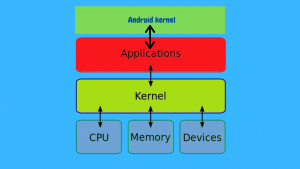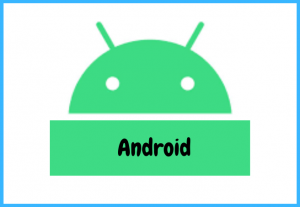Android Operating System
What is the Android Operating system?
The android system is a mobile OS that Google has built to be used specifically for the devices which are touch screens, different kinds of cell phones, and tablets. The android operating system helps users to intuitively control mobile devices with the help of fingers representing the typical motions for example; squeezing, flicking, and clicking. Google also uses Android apps in television sets, vehicles, and smartwatches, and each has a specific user interface. When a computer goes from only running to making life simpler, then Android is behind it. This is why your GPS prevents traffic, the watch will text, and your assistants will be able to ask questions. Within 2.5 billion connected devices it is the operating system. Including 5 G phones to beautiful laptops, they ‘re all powered by Android. Android originally published under open source license Apache v2; this allows for the development of several versions of the OS for many other apps, including gaming consoles even video cameras. Android is free software-oriented; however, most Android apps are preinstalled with commercial software packages including Google Maps, Twitter, chrome browser including google mail.
Figure 1. Android
The versions of the Android operating system.
There are different version numbers of the Android Operating system, which means major differences in functionality, service, and reliability that are typically codenamed. As such, if users understand someone telling you about Android Oreo, Marshmallow, Pie, Nougat, or even the newest Android 10, this is just the brand of the Android version you could have on your device. New smartphones and tablets launched this year often function Android 9 Pie or Android 10. Because Android 11 is scheduled to happen eventually this year. Manufacturing companies of Android devices, including Motorola, Samsung, Sony, HTC, OnePlus, and many others typically have such a layer on the highest point of the Operating system. A screen, or UI layer, is essentially a customized interface that applies additional features to your handset, numerous symbols, as well as other modifications intended to provide such a memorable experience for your preferred phone manufacturer. The most common skins are OnePlus, One UI for Samsung, EMUI for Huawei, and Oxygens. A mobile with no significant customization options is usually referred to as “Android stock,” and UIs only with small alterations (such as those discovered with Motorola mobile devices) are sometimes started referring to as relatively close-stock.
The kernel.
Android devices just use Linux kernel and bet that each and every phone chooses one’s own edition. Linux kernel maintenance personnel keep it up-to-date and accessible, participants (like Google) add or change stuff to best satisfy their purposes, and the hardware manufacturers often participate since they need to create hardware drivers for both the components they use for the kernel version they need. That’s why it’s taken individual Android developers and attackers a little while to transfer updated models to older devices and get everything to functioning. Drivers designed for mobile to function on one edition of the kernel could not function on the very same device with another version of the software. That’s essential since control of the equipment is one of the main functions of the kernel. It’s a huge amount of code, with far more choices than you can assume when constructing it, but basically, it’s really just the interface between both the hardware and the software. If the application allows the hardware to get anything, it makes a query to the kernel. So, when we suggest something, we assume something. From display settings to volume amount, to triggering a call through radio, the kernel inevitably controls even what is really attracted on the display. For example, you inform the program to open the lookup implementation when you press the search feature on your mobile device. What occurs would be that you tapped on the digital file of a certain moment, which informs the program that you tried to touch the screen at those latitudes and longitude. The software understands that the selection dialog should open when another specific spot is wanted to touch. The kernel is also what informs the digitizer to search for hits (or pay attention to things being “started listening” for), helps figure out how you touched, and goes on to tell the machine that you touched it. In turn, when the receiver contains a touch event from the kernel (through to the driver) at a particular point it understands what to catch on your display. That both hardware, as well as software, interact with the kernel in both directions and this is how your computer learns when to be doing something.

Figure 2. Android OS kernel
Android operating system vs IOS.
Android-based operating systems as well as Apple’s iOS both platforms that are mainly seen in touch screen devices, for example; a smartphone as well as tablets. Android operating system which really is an open source operating system based on Linux, is much more Personal computer like than iOS because its main things and design are usually quite customized through beginning to end. Unified interface elements of iOS, nevertheless, are often seen as quite consumer friendly. You must wisely select your phone and tablet technologies, as moving between iOS to Android or conversely would allow you to purchase devices from the google play store and Apple App Store respectively. Android has become the most widely used mobile platform in the world, which is used by several various manufacturers of phones. Apple products including the iPhone using iOS exclusively. Verily, statistics are not really the best measure since most of us use just a couple of apps as well as the most common ones that are accessible from both systems. Historically, iOS has become a more profitable platform for programmers, and new apps have tended to launch there first, but that’s shifting as Android’s share of the market continues to increase. iOS often paves the market in the U.S. but programmers are also approaching Android more and more first. The android application is 2.5 million worldwide and the IOS application is 1.8 million worldwide. Battery life is a major factor, as one of the key issues for phone users. Comparing the two architectures is complicated since there is no popular hardware. We might argue that iOS is designed to get more out of the batteries per MAH value, and you can buy the android phone with the much larger battery that comfortably outweighs the iPhone. All Android and iOS provide you with a snapshot of your battery consumption, decomposed by the app, and only Android provides an estimation about how much battery capacity you’ve left. Both provide energy-saving settings that can prolong your battery capacity by restricting efficiency, networking, and other energy-sapping functions, and it’s usually quite flexible on Android specifically how it functions. Android had such a long-term edge in the storage field, as many android devices provided charging stations and inductive charging capability. Apple’s iPhone X, iPhone 11, and even the iPhone SE launched in 2020 have, embraced replaceable batteries and battery capacity, but they’re not behind in. On certain new iPhones, it’s important to remember that you have to purchase the fast-charging charger individually, although it’s normally bundled via an android device in the package.

Figure 3. Android Vs iOS
